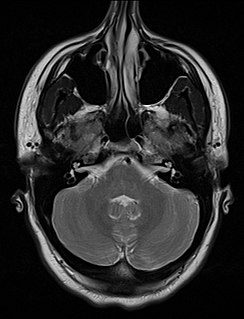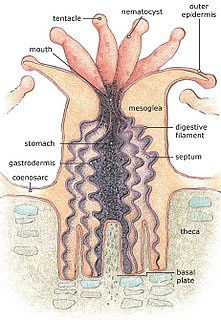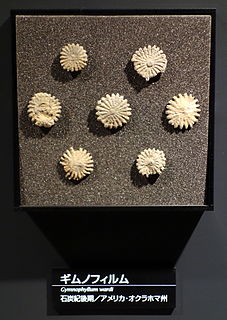| Look up septa in Wiktionary, the free dictionary. |
Septa may refer to:
| Look up septa in Wiktionary, the free dictionary. |
Septa may refer to:
| This disambiguation page lists articles associated with the title Septa. If an internal link led you here, you may wish to change the link to point directly to the intended article. |
In biology, a septum is a wall, dividing a cavity or structure into smaller ones.

The Rugosa, also called the Tetracorallia, are an extinct order of solitary and colonial corals that were abundant in Middle Ordovician to Late Permian seas.

Nasal septum deviation is a physical disorder of the nose, involving a displacement of the nasal septum. Some displacement is common, affecting 80% of people, mostly without their knowledge.

Septa are thin walls or partitions between the internal chambers (camerae) of the shell of a cephalopod, namely nautiloids or ammonoids.

The interatrial septum is the wall of tissue that separates the right and left atria of the heart.

A corallite is the skeletal cup, formed by an individual stony coral polyp, in which the polyp sits and into which it can retract. The cup is composed of aragonite, a crystalline form of calcium carbonate, and is secreted by the polyp. Corallites vary in size, but in most colonial corals they are less than 3 mm (0.12 in) in diameter. The inner surface of the corallite is known as the calyx. The vertical blades inside the calyx are known as septa and in some species, these ridges continue outside the corallite wall as costae. Where there is no corallite wall, the blades are known as septocostae. The septa, costae and septocostae may have ornamentation in the form of teeth and may be thick, thin or variable in size. Sometimes there are paliform lobes, in the form of rods or blades, rising from the inner margins of the septa. These may form a neat circle called the paliform crown. The septa do not usually unite in the centre of the corallite, instead they form a columella, a tangled mass of intertwined septa, or a dome-shaped or pillar-like projection. In the living coral, the lower part of the polyp is in intimate contact with the corallite, and has radial mesenteries between the septa which increase the surface area of the body cavity and aid digestion. The septa, palliform lobes and costae can often be seen through the coenosarc, the layer of living tissue that covers the coenosteum, the part of the skeleton between the corallites.
The fascial compartments of the leg are the four fascial compartments that separate and contain the muscles of the lower leg. The compartments are divided by septa formed from the fascia. The compartments usually have nerve and blood supplies separate from their neighbours. All of the muscles within a compartment will generally be supplied by the same nerve.
Columella was a Roman writer.

The posterior intermuscular septum of leg, or posterior crural intermuscular septum is a band of fascia which separates the lateral compartment of leg.

The anterior intermuscular septum of leg or anterior crural intermuscular septum is a band of fascia which separates the lateral from the anterior compartment of leg.
A vaginal septum is a vaginal anomaly that is partition within the vagina; such a septum could be either longitudinal or transverse. In some affected women, the septum is partial or does not extend the length or width of the vagina. Pain during intercourse can be a symptom. A longitudinal vaginal septum develops during embryogenesis when there is an incomplete fusion of the lower parts of the two Müllerian ducts. As a result, there may appear to be two openings to the vagina. There may be associated duplications of the more cranial parts of the Müllerian derivatives, a double cervix, and either a uterine septum or uterus didelphys. A transverse septum forms during embryogenesis when the Müllerian ducts do not fuse to the urogenital sinus. A complete transverse septum can occur across the vagina at different levels. Menstrual flow can be blocked, and is a cause of primary amenorrhea. The accumulation of menstrual debris behind the septum is termed cryptomenorrhea. Some transverse septa are incomplete and may lead to dyspareunia or obstruction in labour.
Heart septal defect refers to a congenital heart defect of one of the septa of the heart.
Knightoconus antarcticus is a species of monoplacophoran from the Cambrian Minaret Formation of Antarctica. It is thought to represent an ancestor to the cephalopods. It had a chambered conical shell, but lacked a siphuncle. The absence of a siphuncle has been taken as evidence against cephalopod ancestry, as the factors that would influence the siphuncle to penetrate preexisting septal chambers remains unknown. The prevailing argument suggests that a strand of tissue remained attached to the previous septum as the mollusc moved forwards and deposited its next septum, stopping that new septum from closing completely and becoming mineralised itself. Ten or more septa are found in mature individuals, occupying around a third of the shell - septa form very early and have been found in specimens as small as 2 mm in length. Unlike monoplacophoran fossils, there is no evidence of muscle scarring in Knightoconus fossils. Scars from the closely related Hypseloconus have been used to determine its orientation. Knightoconus started life with an exogastric shell, that becomes endogastric as the organism grew.

The atrioventricular septum is a septum of the heart between the right atrium (RA) and the left ventricle (LV).

Septa rubecula, common name : the ruby triton or the red redbreast triton, is a species of predatory sea snail, a marine gastropod mollusk in the family Cymatiidae.

Gymnophyllum wardi, commonly known as button coral, is an extinct coral from the Pennsylvanian part of the Carboniferous period. The fossils are found in relatively few places worldwide; most specimens are known from the upper part of the Wewoka formation in and around Lake Okmulgee in Okmulgee State Park or the adjoining Dripping Springs State Park in Okmulgee County, Oklahoma in the United States.

The septum of the scrotum is a vertical layer of fibrous tissue that divides the two compartments of the scrotum. It consists of flexible connective tissue. Its structure extends to the skin surface of the scrotum as the scrotal raphe. It is an incomplete wall of connective tissue and nonstriated muscle dividing the scrotum into two sacs, each containing a testis.
In corals, a septum is one of the radiating vertical plates lying within the corallite wall. Outside the corallite wall these plates are known as costae. The septa may be thick, thin or vary in size. They may have teeth which range from needle-like to blade-like and are often characteristic of different genera.
In corals, a costa is one of the vertical plates lying outside the corallite wall, a continuation of a septum which lies inside the wall. The costae may continue to the edge of the colony and in solitary species, such as those in the family Fungiidae, refers to the ridges on the underside of the coral.

Heterocyathus aequicostatus is a small species of coral in the family Caryophylliidae in the order Scleractinia, the stony corals. It is native to the Indo-Pacific region. It is a large polyp, solitary, free-living coral and is usually found on soft substrates.